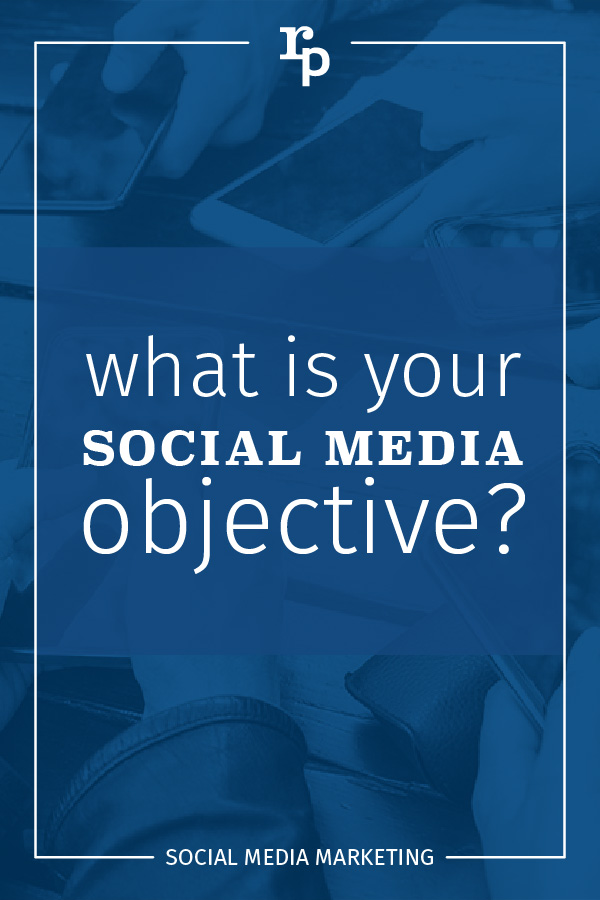What is Your Social Media Objective?
What is your social media objective? Like any marketing activity, there needs to be a reason to devote time and resources. So why is your company using social media? Simple question, right? But the answer isn’t simple because social media can do many things. It can help you build awareness for your brand, track your competitors, and/or interact with your customers. Social media can also be used to develop strategic relationships, and even connect with prospects and customers,
If you are going to measure the results of your activity, you need to decide what your social media objective is. Be realistic, social media can do many things but not all at once.
Which social media objective fits your business?
There are probably as many answers to the why question as there are companies. Each organization will have slightly different reasons for participating, but in general, the social media objectives can be collected into one of four main buckets.
- Brand building – Sharing relevant and helpful information on the right social media channels will help establish your authority as a subject matter expert.
- Community building – You are judged by the company you keep. Social networking can help you find and build relationships with other thought leaders and influential individuals and brands.
- Relationship building – Your customers and prospects are online talking about brands. Social media can be an effective way to monitor and respond to customer service questions and issues.
- Sales building – In some industries, social media can even be effective in generating leads and sales from existing customers and prospects.
So what are you trying to accomplish? Your social media objective will drive the type of content you share, the platforms you choose and the timing of your updates.
Brand building
Social media can be used to increase awareness of who you are and what you do. Here are a few brand building tips:
- Set a schedule for regular updates and share a mixture of relevant information which demonstrates your expertise in the category. This can be content on your site or interesting information you find elsewhere.
- In between your scheduled updates, add some real-time interaction to increase engagement. Ask questions, respond to others. Don’t be afraid to have a little fun on Facebook and Twitter and let some personality shine through.
- Periodically (maybe about 20% of the time) you can add a bit of direct promotion to the feed. Just don’t over do it or you will shut down relationships with people just trying to get to know you.
Community Building
Social media can help you build relationships with referral partners, influential industry experts, and members of the media. Unlike brand building, you can’t just set and forget your social updates. You need to be actively involved in discussion groups on LinkedIn or Facebook or “chats” on Twitter. These forums allow you to share your expertise and “talk” directly to other thought leaders.
If you are trying to connect with members of the media you have to be ready to answer the questions when they are asked, not 3 hours later. For journalists working on a deadline, it is often the person who responds the fastest, and not necessarily the person with the best answer, who will be featured in the article.
Relationship Building
If your objective is to improve relationships with existing customers, you can use social media to address customer service issues and identify product gaps. Encouraging customers to share questions, comments, and even complaints on social media is a double edged sword. On one hand, it presents the image of a progressive customer focused company. You have a chance to get real time feedback and use the information to improve your products and services. On the other hand, it can open up a lot of conversations you may not be ready for.
Before you go down this path, be very sure you have guidelines in place for your customer service team outlining how and when you will respond to customers. It will require lots of time and attention to stay on top of, so if you encourage customers to interact on social media you need to be ready to respond when they do.
If this sounds like too much work, that’s ok, you don’t have to go down this path. As a matter of fact, many large companies have scaled back their social CRM teams in recent years for just this reason. Remember the purpose of this exercise is to find the best use of your time.
Sales building
It is unlikely you will make a $5,000 sale as a result of a 140 character tweet, but you can conduct activities which move prospective customers along your sales funnel. Social media can promote demos and free trials, share informative product comparisons, grow your email list, and distribute coupons.
Creating “user groups” on social media for your most loyal customers can increase buyer frequency and give you a chance to up sell to existing customers.
In conclusion: Set your social media objective then build your plan
Now that you have the basics, go back and look at your social media program. Is it focused on accomplishing specific goals? If not, stop posting for a few days and get organized. No one will notice if you go dark for a few days, get organized, and come back stronger than ever.
not sure where to start your social media program?

Chatbot Basics 101
Favorite Social Media
What is your favorite social media platform? Remember the days when there was just Myspace? Oh,...
Call to Action Do’s and Don’ts
There is such a thing as a bad call to action The goal of any page on a website, whether it's the...
5 Ways to Engage Your Audience on Instagram
With over a billion active users worldwide, Instagram will never run out of fresh visual content....
